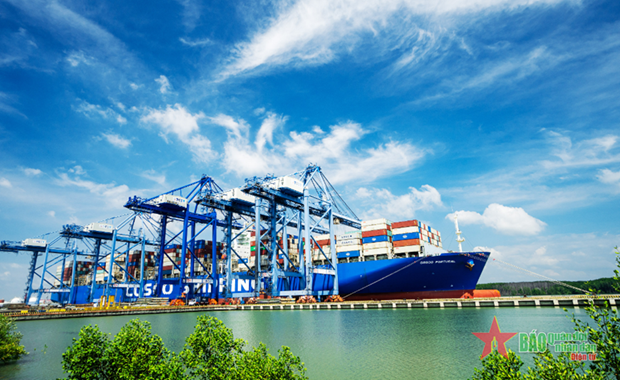
Tan Cang – Cai Mep International Terminal in the southern province of Ba Ria - Vung Tau was awarded the Green Port Award in 2020 (Photo: qdnd.vn)
Therefore, developing green and sustainable ports has become a top priority, an inevitable trend not only for port operators but also managers and international associations, according to insiders.
Over 80% of global trade is transported by sea, but it has resulted in nearly one billion tonnes of greenhouse gas emissions, accounting for nearly 3% of global emissions caused by human activities. This is primarily from the maritime transport sector, experts said at a seminar entitled “Human Resource for sustainable port development" recently which was held recently by the Vietnam Port Association (VPA) in coordination with the Saigon Newport Corporation (SNP).
The event aimed to prepare human resources for developing sustainable ports, addressing climate change and environmental protection.
According to Tran Thi Tu Anh, deputy head of the Science, Technology and Environment Division under the Vietnam Maritime Administration, pollution sources in seaport exploitation activities include the construction of seaports, ports, production and business establishments in the maritime sector and seaport exploitation.
These activities affect air quality, water environment, cause erosion and generate more waste, she added.
Anh held that operators of ports, including the seaport system in the Southeast region, need ensure that their development, construction, and expansion processes are carefully planned and managed to minimise environmental impact.
Bui Van Quy, Deputy Director General of the Saigon Newport Corporation and Chairman of the ASEAN Port Association (APA), said that sustainable port development is one of the top priorities and the seaport system in the Southeast region is no exception.
It is necessary for each component of the maritime and seaport industry to be developed in a greener and smarter orientation, including smart ports, smart ships, smart logistics services, green technology and maritime human resources development.
Nguyen Xuan Ky, General Secretary of APA, Director General of Cai Mep International Seaport, suggested that seaports in the Southeast region should have a reasonable strategy for training and fostering human resources to realise the goal of building green and smart ports.
To solve the problem relating to human resources, the port industry of Ho Chi Minh City has identified two strategic tasks, namely accelerating short-term training for small and medium-sized seaport enterprises to supplement the current workforce shortage and focus on intensive human resource training to have a team of human resources whose quality on par with international standards.
SNP is a pioneer in implementing many measures to build human resources and retain employees, he said.
According to Duong Thanh Khang, Deputy Director General of the Thi Vai Port Complex Joint Stock Company, to build green and smart ports, it is essential to use clean and renewable energy in port exploitation and operation along with the application of information technology to protect the environment. Thus, high-quality human resources are needed to adapt to the digital age, meeting the requirements of sustainable seaport development.
Participants at the seminar underlined the need to implement a single-window maritime mechanism to reduce vessel berthing time at ports. Ports also need to adopt solutions to provide clean and sustainable energy, along with the establishment of sustainable human resources./.
VNA
 Digital promotions reshape Vietnam’s e-commerce race
Digital promotions reshape Vietnam’s e-commerce race



